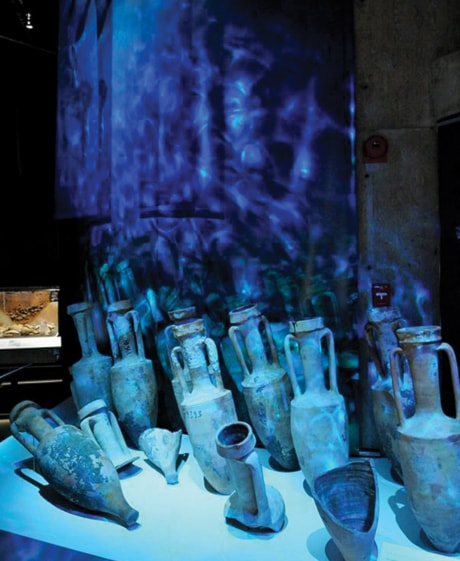MONTREAL — The history of France bears witness to the raw power of a hangover headache — after all, alcohol overconsumption and a hard-partying lifestyle apparently devastated the entire Gallic civilization.
That libation-laden past is on display in Montreal until Oct. 16 at the city’s Pointe-a-Calliere museum in an exhibit called, To Your Health, Caesar! Wine and the Gauls.
The surprising find of hundreds of ceramic containers of wine in a shipwrecked hull at the bottom of the Mediterranean in 1972 reconfirmed the theory that the Gauls liked to drink — a lot.
Distinctly designed containers from the ill-fated shipment, along with artifacts from the Roman Empire, are part of the display.
A half-hour stroll through the exhibit illustrates wine’s exalted status within the Gallic and Roman civilizations.
“When the Gauls discovered wine,” said exhibit curator Christine Dufresne, “they were under the influence of Rome and Greece. Wine was really a symbol of power.”
Starting with a look at wine’s origins, the interactive multimedia tour debunks a common misconception that production began with the Italians or Greeks.
It highlights discoveries in the Middle East as far back as 5,400 BC, of jars believed to have been made specifically to contain wine.
Long considered the drink of the upper ruling class, wine’s historical status is illustrated by Gallic offerings to Bacchus, the wine god.
The offerings were various metal objects, a highly coveted material at the time.
So revered was the beverage that upon death, members of royalty were often placed in their tomb accompanied by a supply of wine — and they weren’t stingy with the grape.
The exhibit includes a reproduction of a portion of the largest ancient bronze ever discovered — a 1,100-litre behemoth of a container located in the tomb of a princess from the village of Vix, near Burgundy, France. The vase’s excavation is documented in an accompanying 3D film.
Such copious amounts of wine being splashed around France came with obvious costs, both social and economic.
The repercussions, for Gallic civilization, were epic.
“Gauls were great drinkers of wine,” said Dufresne, “but were not great producers,” which forced them to import millions of litres from Italy.
The high taxation placed upon wine led to substantial dividends for the Roman exporters, allowing them to expand both in wealth and strength. This enabled a rapid growth of the Roman military, culminating in the conquest of Gaul by Caesar’s troops in 51 BC..
“Maybe if the Gauls were more moderate in their drinking, they would not have been so easily conquered,” said Dufresne, echoing a sentiment Caesar himself hinted at in his prolific diaries of the Gallic conquest.
After their defeat, the Gauls began taking revenge over the Romans. They planted their own vineyards and learned to make wine themselves. Today areas of old Gaul are the world-famous wine-producing regions of France — Bordeaux, Rhone, and Beaujolais.
The Montreal exhibit also illustrates the extensive time and resources dedicated to wine production.
It examines not only the beverage itself, but the buildings that housed thousands of large terracotta dolium in which the wine was fermented and also the amphorae used for storage.
“Wine was so precious and important,” said Dufresne, “that many small containers used for perfumes or oils were in the form of an amphora.”
While most of today’s wine choices focus on white, red, or rose, ancient wines were frequently flavoured with salt, herbs, and spices. The use of pine resin to seal the dolium had the unexpected, but welcome, effect of preserving the wine against spoilage.
With a nod to both modern-day production and consumption, the exhibit also includes a time capsule from Quebec’s liquor commission showcasing products and pricelists from the early days of its 90-year reign as the provincial supplier of spirits.
Besides being an historical journey into the evolution of winemaking, the exhibit provides a few surprises — like period costumes, coins, and weapons.
Fortunately, this is one vinaceous experience that won’t leave you groping for your coffeemaker and Tylenol the next morning.
For more information on museum hours and rates, visit their website at www.pacmusee.qc.ca
